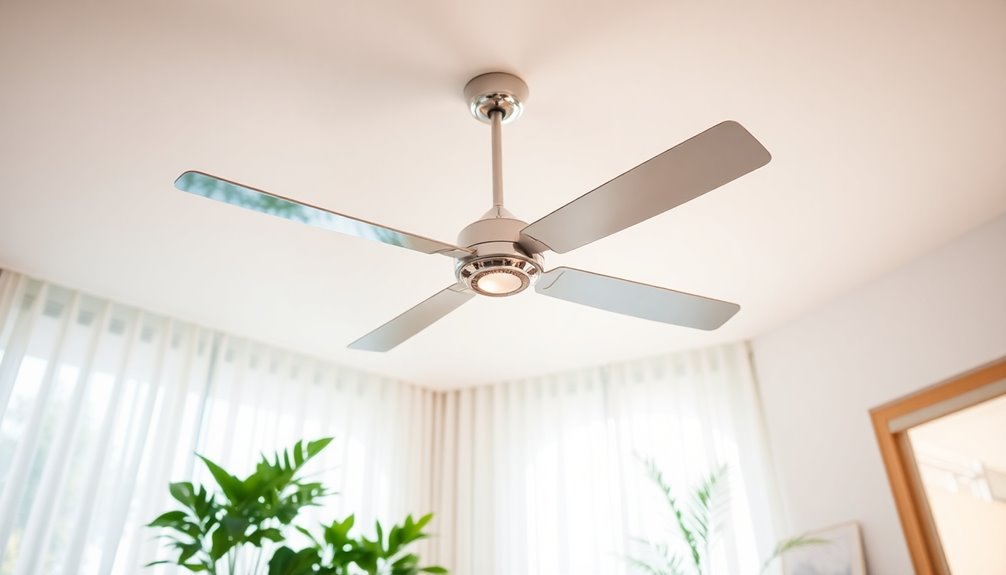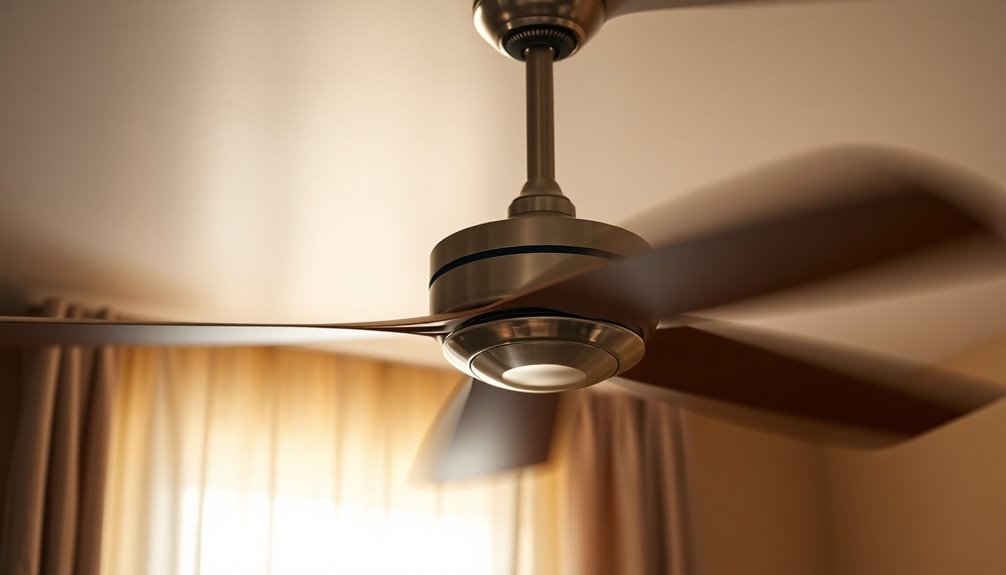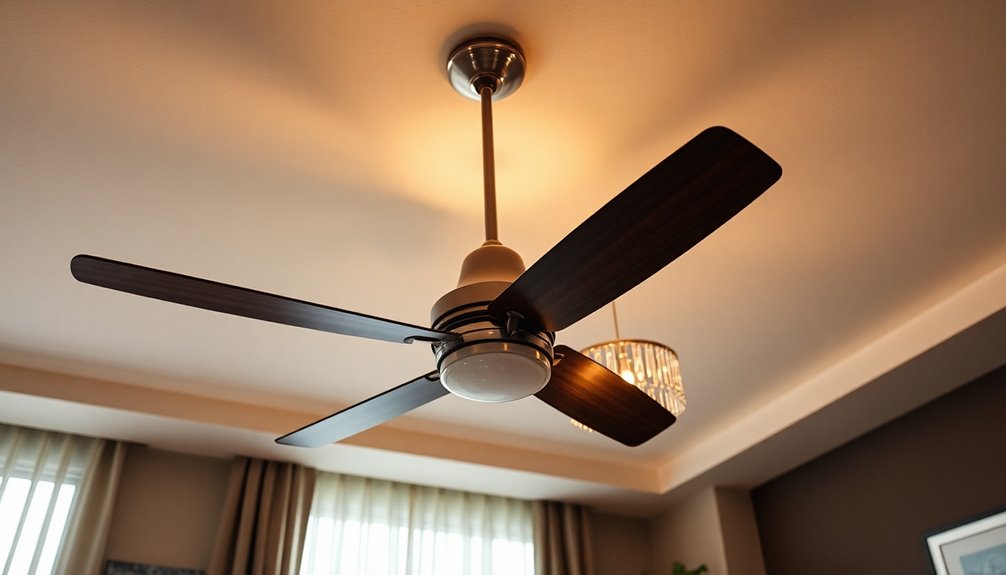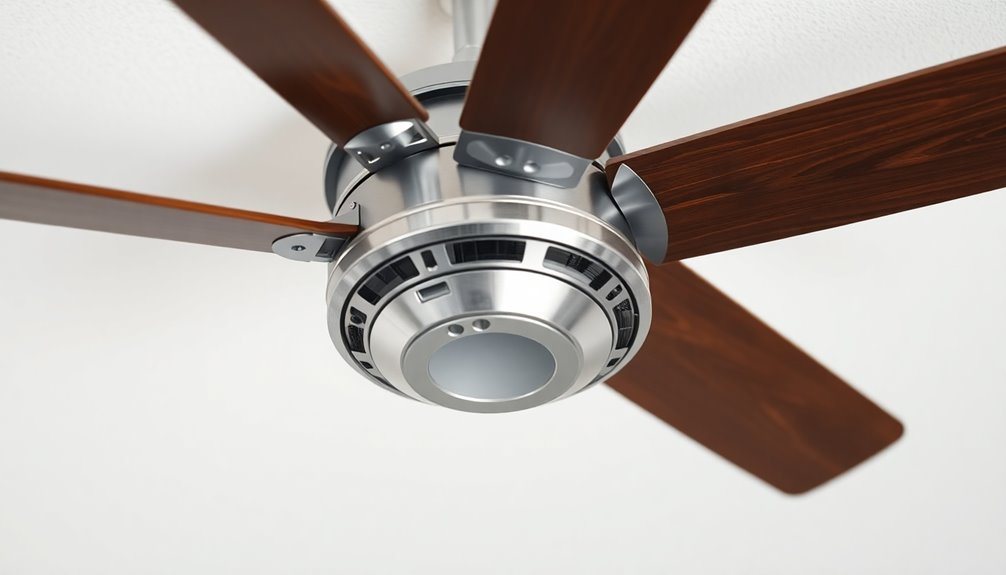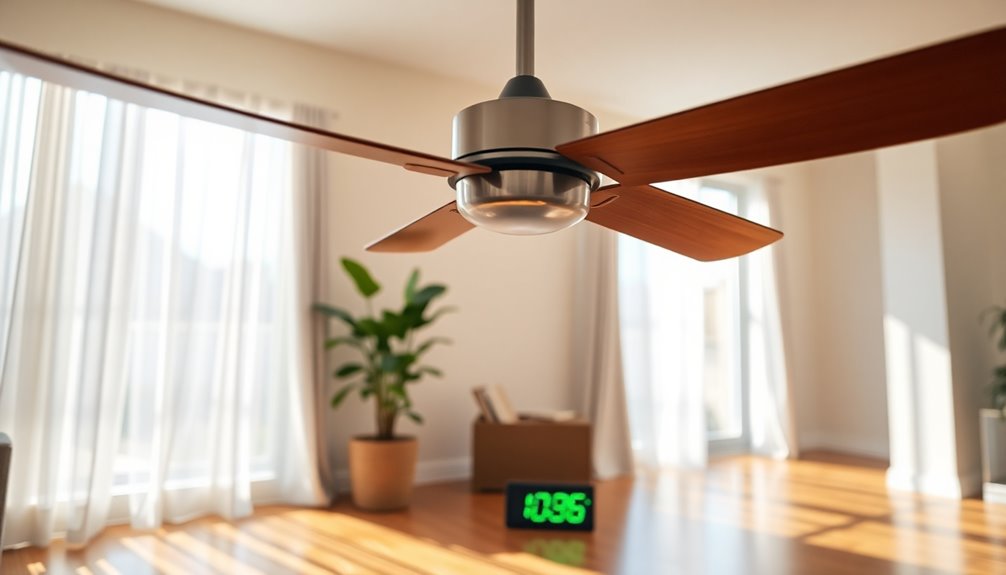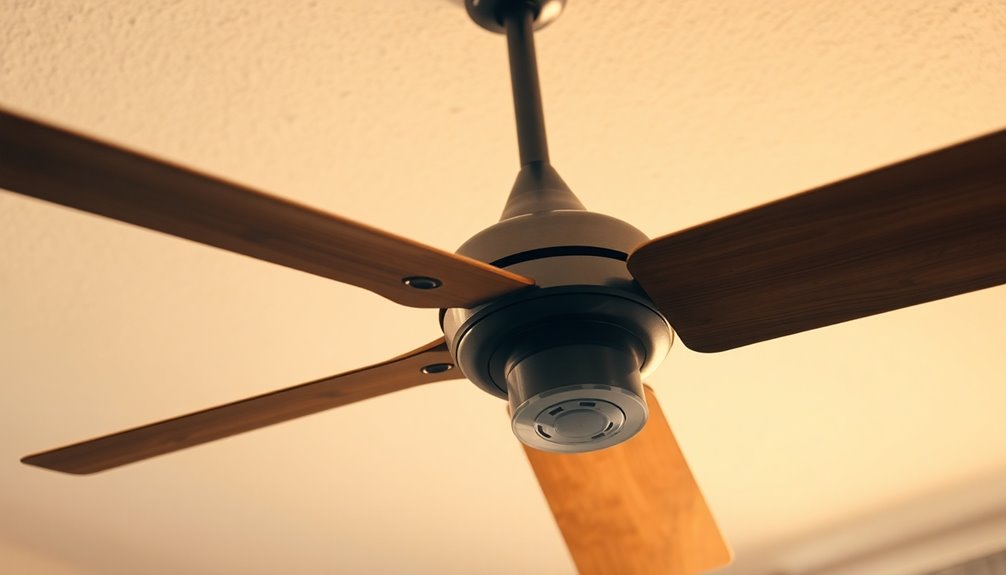In the summer, your ceiling fan should spin counterclockwise. This rotation creates a revitalizing downdraft that helps cool down your room, making it feel 4°F to 7°F cooler. You'll benefit from reduced reliance on air conditioning, allowing you to raise your thermostat by about 4 degrees without sacrificing comfort. To confirm it's turning the right way, stand under the fan and feel for the breeze. Remember to switch the direction back to clockwise in the winter for maximum warmth. If you stick around, you'll discover even more tips to enhance your comfort and energy savings.
Key Takeaways
- Ceiling fans should rotate counterclockwise in summer to create a cooling downdraft.
- This direction can make a room feel 4°F to 7°F cooler.
- Adjusting the thermostat by 4 degrees while using fans can save on cooling bills.
- Ensure fan blades have a minimum angle of 12 degrees for optimal airflow.
- Regularly check and adjust the fan direction seasonally for maximum efficiency.
Importance of Ceiling Fan Direction
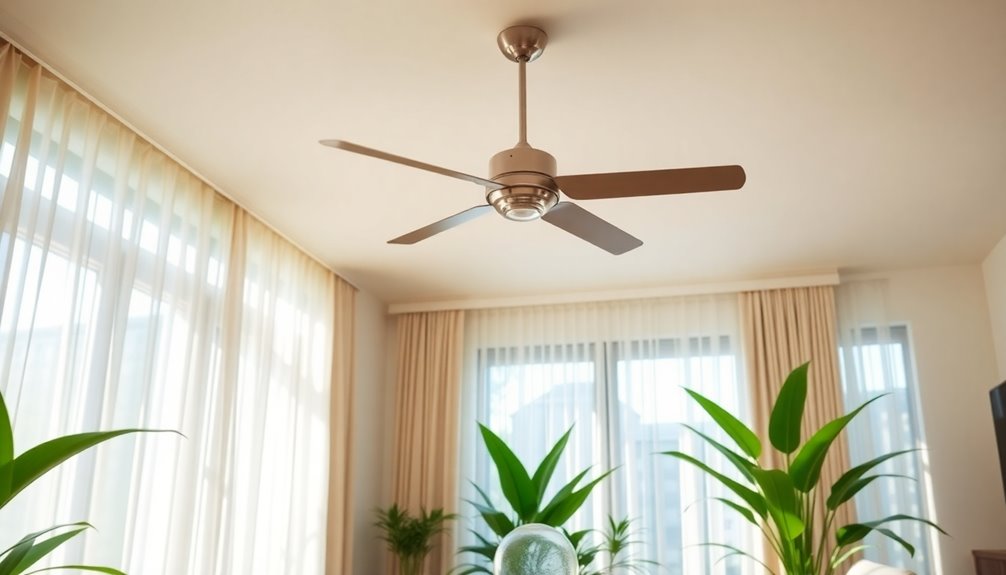
When it comes to staying comfortable during the summer months, the direction of your ceiling fan plays an important role. Setting your ceiling fan to spin counterclockwise is essential for maximizing cooling and guaranteeing ideal airflow. This rotation creates a downdraft, which generates a rejuvenating breeze, making the room feel cooler than it actually is. Additionally, ensuring that your fan is properly maintained can prevent potential dangerous situations related to mechanical failure. Regularly lubricating the fan can contribute to optimal fan performance, further enhancing its efficiency.
By using your ceiling fan correctly, you can increase your thermostat settings by about 4 degrees without sacrificing comfort. This adjustment not only enhances your indoor experience but also leads to significant savings on energy costs. In fact, running a ceiling fan counterclockwise can reduce your energy expenses by up to 30%, making it a smart alternative to relying solely on air conditioning.
It's crucial to remember that seasonal adjustments to fan direction are necessary. If your ceiling fan spins in the wrong direction, you risk inadequate airflow that can lead to discomfort during hotter months. Additionally, using a ceiling fan can enhance the effectiveness of an air purifier by improving air circulation, ensuring that cleaner air is distributed throughout the room. Moreover, modern fans are designed with increased efficiency that allows them to operate effectively while consuming less energy, making them a great investment for any home.
Keeping your ceiling fan direction in mind guarantees you enjoy a cooler environment while also being energy-efficient. So, don't overlook this simple adjustment—your comfort and wallet will thank you!
Summer Ceiling Fan Settings
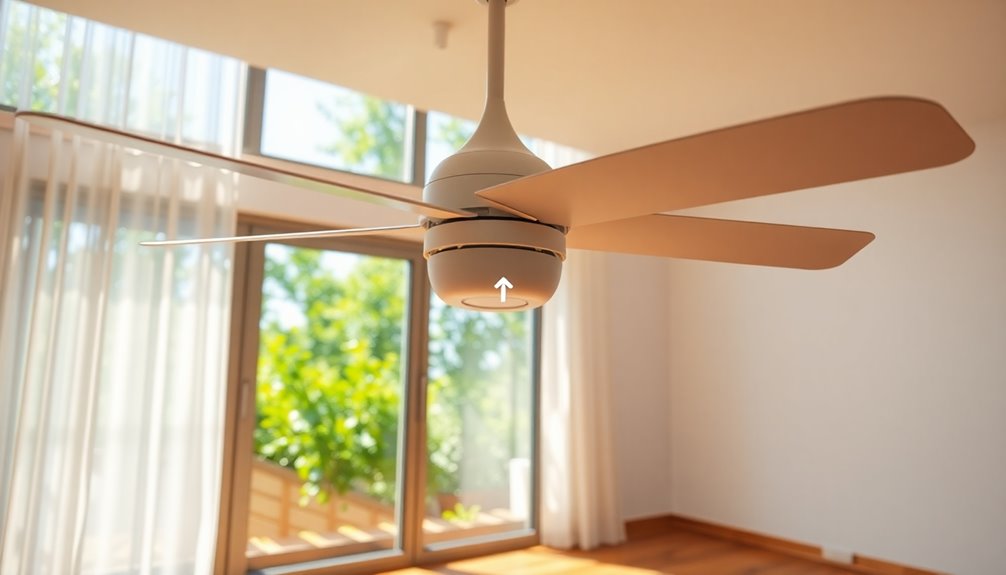
To keep your home comfortably cool during the summer, it's crucial to set your ceiling fan correctly. You want to adjust the ceiling fan direction to spin counterclockwise. This rotation creates a cooling downdraft that enhances airflow and helps lower the perceived temperature in the room.
When your ceiling fan runs in counterclockwise mode, it generates a wind chill effect, allowing you to increase your thermostat settings by about 4 degrees without sacrificing comfort. You'll notice how invigorating the air feels as it rushes downward.
To confirm it's spinning the right way, just stand under the fan and feel the cool breeze.
Using your ceiling fan in summer mode can also lead to significant energy savings—up to 30%—by reducing reliance on air conditioning. This not only helps your wallet but also benefits the environment.
How to Change Direction
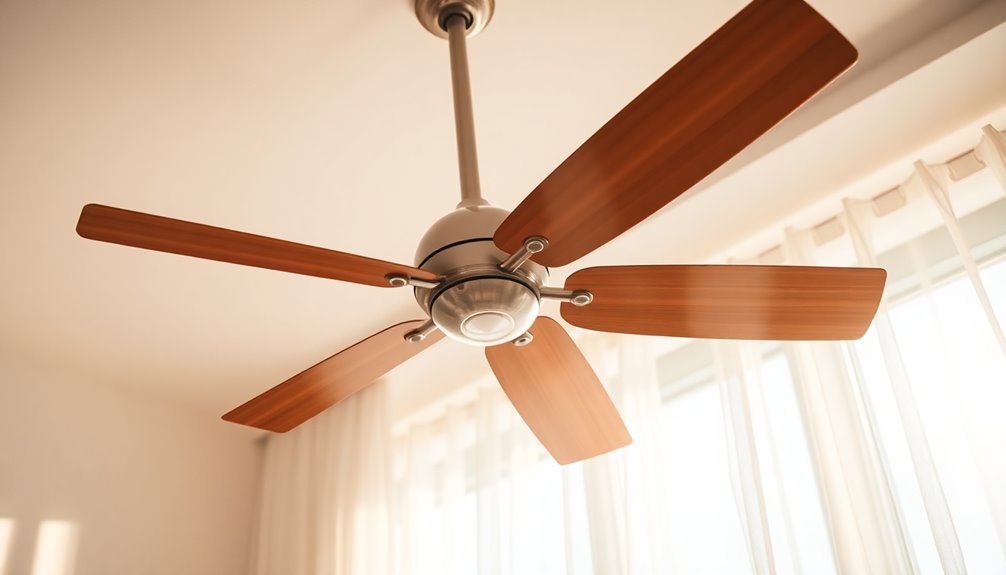
Changing the direction of your ceiling fan for summer is a straightforward process that guarantees you enjoy ideal cooling. To create that invigorating cooling downdraft, follow these simple steps:
- Turn off the fan: Safety first! Make sure your ceiling fan is off and completely stopped.
- For pull chain fans: Locate the ceiling fan switch on the fan body. Toggle it to switch the direction to counterclockwise.
- For remote-controlled fans: Turn off the fan, then press and hold the fan button on the remote until a light blinks, indicating a successful direction change.
- For smart fans: If you have a smart fan, use the compatible app or voice commands to adjust it to counterclockwise.
Once you've made the adjustments, turn the fan back on.
Check to confirm it's spinning counterclockwise; this will guarantee the best cooling downdraft you need during those hot summer months.
Following these steps will keep your space comfortable and enjoyable all season long!
Energy Savings With Ceiling Fans
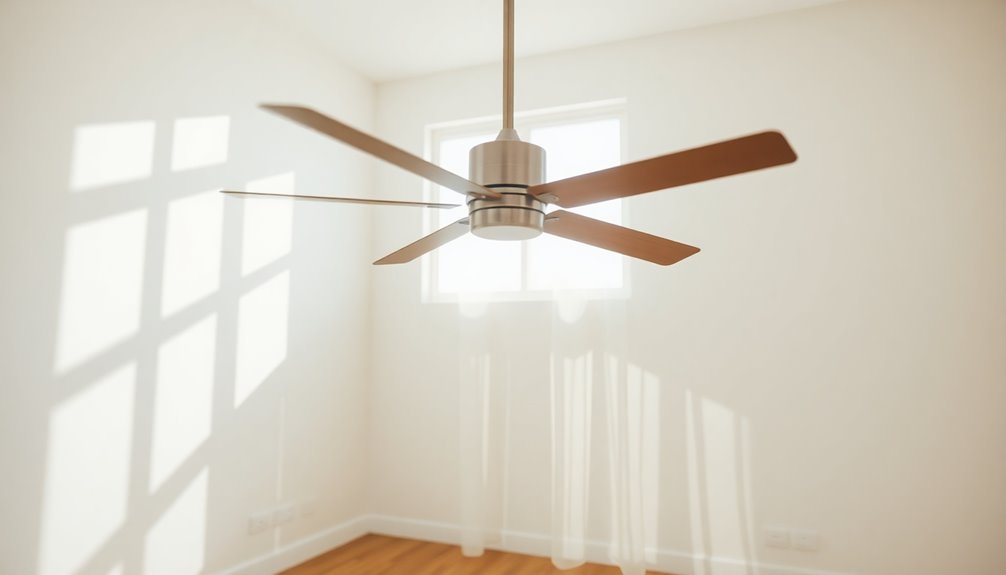
Utilizing a ceiling fan in the summer not only enhances your comfort but also leads to significant energy savings. When you run your fan in the right direction, it creates a cooling downdraft that provides a wind chill effect, making your space feel cooler without drastically lowering the temperature.
Ceiling fans consume only about 50 watts of energy, compared to the whopping 3,500 watts used by air conditioning units. This difference can help you save substantially on your energy costs.
By pairing your ceiling fan with an ENERGY STAR-rated air conditioning unit, you can boost cooling efficiency by up to 8%. You can also adjust your thermostat by about 4 degrees while using the fan, potentially cutting your cooling bills by up to 30%.
To maximize airflow and cooling efficiency, verify the fan blades have a minimum angle of 12 degrees.
This summer, embrace the energy savings that come with the right ceiling fans direction. You'll feel cooler while keeping your air conditioning costs in check, allowing you to enjoy your space without breaking the bank.
Understanding Clockwise and Counterclockwise
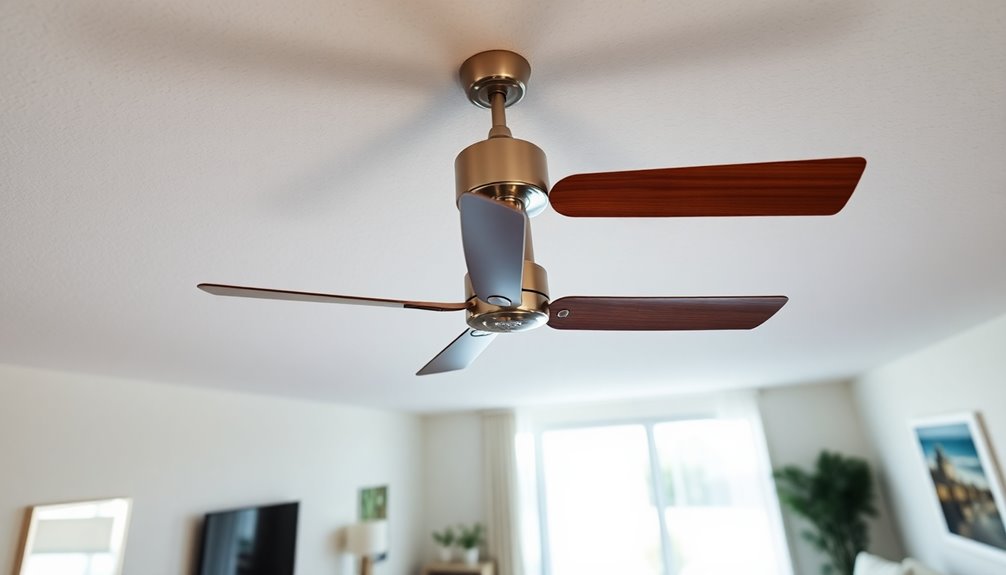
When you think about ceiling fan rotation, it helps to visualize a clock face.
Clockwise rotation moves air to the right, while counterclockwise goes left, creating a revitalizing downdraft.
Understanding these directions is key to optimizing your fan's cooling ability in the summer.
Defining Rotational Directions
Understanding rotational directions is essential for effectively using your ceiling fan, especially during the summer months.
The direction your ceiling fan spins directly impacts its cooling capabilities. Here's how to identify clockwise and counterclockwise movements:
- Clockwise: This motion moves to the right, mimicking the hands of a clock. It corresponds to the path from 12 to 6 on a clock face.
- Counterclockwise: This rotation moves to the left, reversing the clock hands' direction, going from 12 to 6 and back to 12.
- Cooling Effect: During summer, setting your ceiling fan to rotate counterclockwise enhances airflow, creating a cooling breeze that can lower the perceived temperature in your space.
- Warming Effect: In contrast, a clockwise rotation is more effective in winter, circulating warm air downwards.
Visualizing Fan Movement
Visualizing fan movement is key to mastering your ceiling fan's operation. Understanding fan direction helps you optimize your comfort and energy efficiency.
When you want to create a cool breeze in the summer, make sure your ceiling fan blades spin counterclockwise. This motion pushes air downward, providing a revitalizing airflow that cools your space. Imagine the blades moving from 12 to 6, just like clock hands turning to the left.
On the flip side, if you need warmth during the winter, you'll want the fan to rotate clockwise. This clockwise rotation moves air upward, creating an updraft that circulates warm air throughout the room. Picture the opposite direction: blades moving from 12 to 6 on the right.
Optimal Blade Angle for Cooling
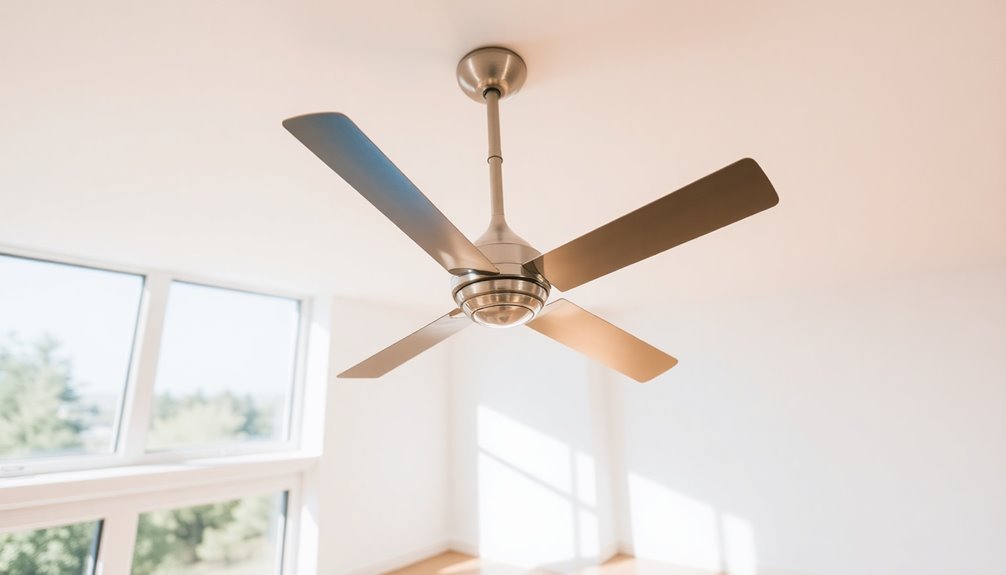
To get the most out of your ceiling fan this summer, you need to pay attention to the blade angle.
Setting it at a minimum of 12 degrees can greatly boost airflow and cooling efficiency.
Just remember, going above 16 degrees might create a bit of chaos with loose objects in the room, so find that sweet spot for ideal comfort.
Blade Angle Efficiency
When it comes to maximizing the cooling effect of your ceiling fan, the blade angle plays an important role. To guarantee ideal cooling efficiency, here are four key points to take into account:
- Minimum Angle: Aim for a blade angle of at least 12 degrees. This allows for maximum airflow, enhancing the cooling effect.
- Avoid Excessive Angles: Angles exceeding 16 degrees can disrupt airflow, causing unnecessary turbulence that might affect loose objects in the room.
- Comfort in Larger Spaces: In larger areas, maintaining the right blade pitch is vital. You might need multiple fans to achieve the desired comfort level.
- Energy Efficiency: Regularly checking and adjusting the blade angle can greatly reduce energy consumption, as it improves the fan's ability to circulate air efficiently.
Airflow Maximization Techniques
Maximizing airflow is crucial for keeping your space cool during the summer months. To achieve this, focus on the blade angle of your ceiling fan. For ideal cooling, set the blades at a minimum angle of 12 degrees. This enhances airflow efficiency and guarantees you get that cool air circulating effectively throughout your room.
Be cautious, though—angles above 16 degrees can create excessive turbulence, which may disrupt lightweight objects.
When determining the fan direction in summer, make sure it spins counterclockwise. This creates a wind-chill effect, which helps keep cool without drastically lowering the thermostat. If you're dealing with a larger room over 500 square feet, consider using multiple fans to maximize airflow and comfort.
Regular maintenance is also key. By checking and adjusting the blade direction as needed, you can greatly improve your cooling performance.
Keeping your ceiling fan in ideal shape not only enhances airflow efficiency but also boosts the overall energy efficiency of your cooling system. So, take the time to fine-tune your fans and enjoy a more comfortable summer environment.
Timing for Seasonal Changes

As spring approaches and Daylight Savings Time begins, it's the perfect moment to switch your ceiling fan's direction for summer.
Shifting to summer mode sets your fan to rotate counterclockwise, creating a cooling downdraft that helps lower your comfort levels. This simple seasonal change can greatly enhance your indoor climate and boost energy efficiency during the warmer months.
To make the most of this shift, consider these four steps:
- Check the Fan Direction: Verify your fan is set to rotate counterclockwise.
- Optimize Size: Make sure your fan is appropriately sized for the room to maximize its cooling benefits.
- Regular Changes: Don't forget to adjust the fan direction with the seasons. This habit can lead to considerable energy savings.
- Monitor Comfort Levels: Pay attention to how the airflow feels and adjust if needed.
Ceiling Fan Direction in Different Rooms
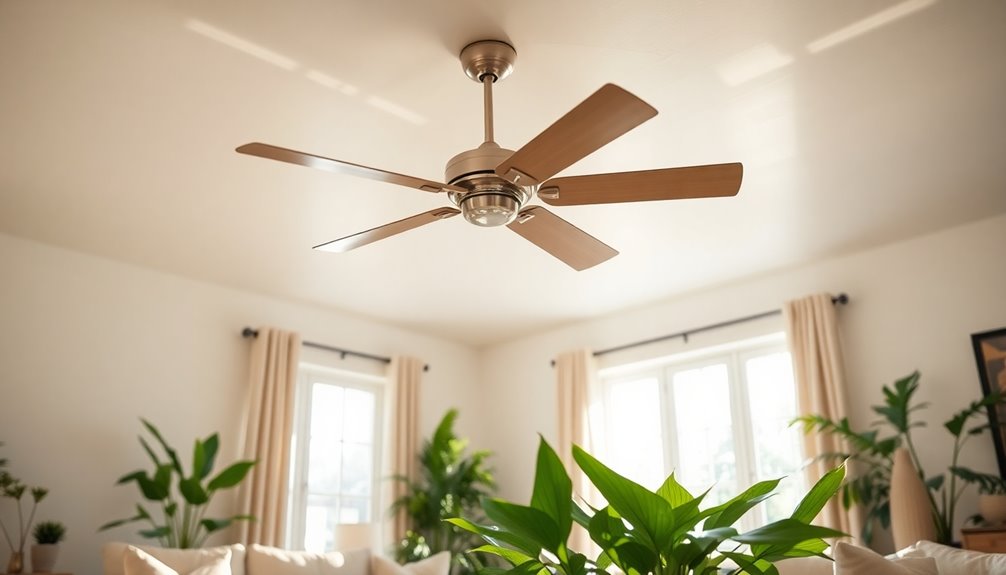
When it comes to ceiling fan direction, different rooms require specific settings for ideal comfort and airflow.
You'll want to adjust the fan's rotation and speed based on the room's purpose and layout.
Understanding these room-specific needs can help you maintain a comfortable environment throughout your home.
Room-Specific Fan Settings
Choosing the right ceiling fan direction can make a significant difference in comfort levels across various rooms in your home.
By adjusting the fan settings to suit each space, you can effectively cool your home and enhance air circulation.
Here's how to set your ceiling fans for different rooms:
- Dining Room: Turn counterclockwise at medium or high speed. This creates a revitalizing wind chill effect, making your meals more enjoyable.
- Home Office: Keep the fan on medium counterclockwise. This setting improves comfort without disturbing your papers or work materials.
- Vaulted Ceilings: Maintain a counterclockwise direction year-round. This guarantees minimal wind chill while promoting ideal air circulation.
- Outdoor Areas: Use a high-speed counterclockwise rotation to provide a breezy atmosphere and help control pesky insects.
Optimal Fan Placement
Finding the right placement for your ceiling fan can greatly enhance comfort in any room. In summer, you want your ceiling fan direction set to counterclockwise. This creates a cooling downdraft that helps make you feel more comfortable by circulating air effectively.
Here's a quick overview of ideal fan placement for different rooms:
| Room Type | Recommended Direction |
|---|---|
| Living Room | Counterclockwise (high speed) |
| Dining Room | Clockwise (medium/low speed) |
| Home Office | Clockwise (medium speed) |
| Outdoor Space | Counterclockwise (high speed) |
In rooms with vaulted ceilings, keep the fan on counterclockwise year-round to guarantee proper air circulation without creating excessive wind chill. For dining rooms, a medium/low speed set to clockwise can help distribute warmth without cooling your food too quickly. Home offices benefit from a clockwise setting at medium speed to minimize paper movement while keeping the air comfortable. Finally, outdoor fans should also rotate counterclockwise at high speed to improve air circulation and help control insect populations.
Seasonal Adjustments Needed
Adjust your ceiling fan direction seasonally to maximize comfort and efficiency in each room. In the summer, you'll want your ceiling fan to turn counterclockwise. This ceiling fan direction creates a cooling downdraft that enhances air circulation and helps regulate your indoor temperature.
Here's how to adjust your fans in different spaces:
- Living Room: Set your fan to counterclockwise at medium or high speed to enjoy a revitalizing breeze while you relax.
- Dining Room: Use the same counterclockwise setting to guarantee guests feel comfortable without relying solely on air conditioning.
- High Ceilings: If you have high ceilings, keep your fan spinning counterclockwise year-round to minimize wind chill while still promoting air circulation.
- Outdoor Spaces: Change your ceiling fan direction to counterclockwise to aid cooling and help keep insects at bay.
General Ceiling Fan Tips
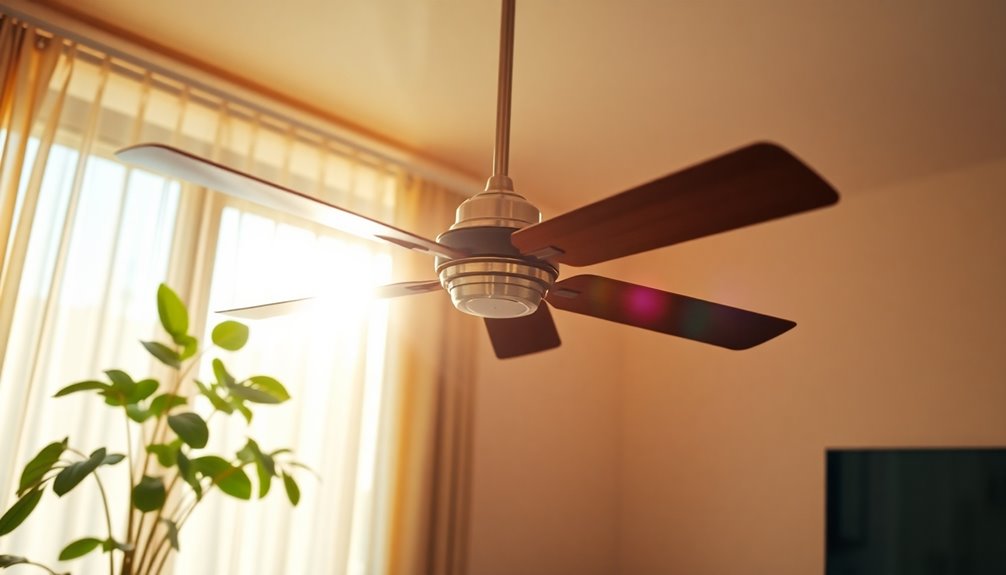
When it comes to maximizing comfort during the hot summer months, understanding how to use your ceiling fan effectively is essential.
Set your ceiling fan direction to counterclockwise to create a cooling downdraft. This helps enhance comfort by generating a wind chill effect that cools you directly, allowing you to raise your thermostat setting by about 4 degrees without sacrificing comfort. As a result, you can enjoy significant energy savings—up to 30% on your cooling costs!
To guarantee ideal airflow, make sure the fan blades are adjusted to a minimum angle of 12 degrees.
Regular maintenance is also vital. Keep the blades clean and check the motor to maintain your fan's performance. A well-maintained ceiling fan won't only deliver cool air more efficiently but will also contribute to better energy efficiency during the summer. Additionally, regularly checking and cleaning filters in your air purifier can enhance overall indoor air quality, making your living space even more comfortable during hot weather.
Additional Energy Efficiency Strategies
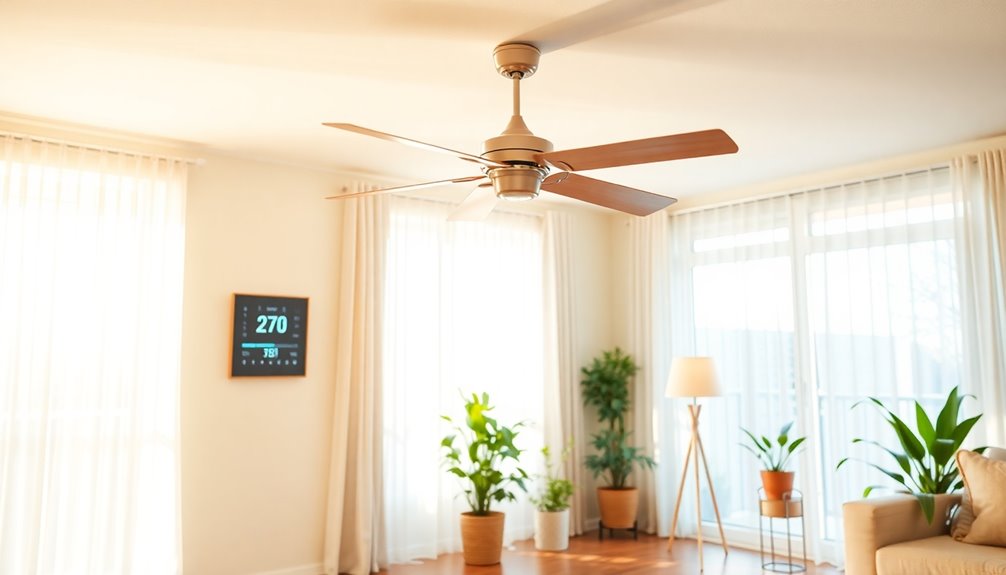
Implementing additional energy efficiency strategies can greatly reduce your cooling and heating costs.
It's essential to optimize your home's systems, especially during the summer months. Here are some effective ways to enhance energy efficiency:
- Conduct a home energy audit: Identify areas where energy savings can be achieved, allowing you to target improvements effectively.
- Change the ceiling fan direction: In summer, set your ceiling fan to rotate counterclockwise to push cool air down, creating a wind-chill effect. This can complement the use of modern heat pumps which are designed for quieter operation and energy efficiency. Heat pumps can also effectively transfer thermal energy, making them a valuable addition to your cooling strategy. Additionally, these systems can achieve efficiency ratings of 300% to 600%, further enhancing your home's cooling capabilities.
- Pair ceiling fans with ENERGY STAR-rated air conditioners: This combo can increase overall efficiency by up to 8%, maximizing your energy savings.
- Perform regular maintenance: Clean the fan blades and make sure they're properly aligned to enhance performance and energy efficiency.
- Consider integrating energy-efficient heat pumps into your home's cooling system for even greater savings on energy bills.
Frequently Asked Questions
How Do You Tell if Your Ceiling Fan Is Going Clockwise or Counterclockwise?
To tell if your ceiling fan's going clockwise or counterclockwise, just stand directly beneath it and watch the blades.
If they're rotating to the right, it's moving clockwise; to the left means it's counterclockwise.
You can also feel the airflow—if you get a noticeable breeze, it's likely counterclockwise.
Most fans have a switch on the motor housing to easily change the direction when the fan's off, making it a breeze to adjust.
Which Way Should Ceiling Fans Go in the Winter?
Imagine your cozy haven, where warmth dances in the air.
In winter, you want your ceiling fan to spin clockwise at a low speed. This gentle movement creates an updraft, pushing warm air down and banishing those pesky cold spots.
You'll feel snug without the chill of a direct breeze, and your utility bills might just thank you.
What Direction Should I Face My Fan?
When deciding which direction to face your fan, consider the airflow you want to achieve.
If you want cooling, position it so it pushes air downward towards you. This creates a revitalizing breeze.
For warming, direct the airflow upward to circulate warm air around the room.
Always check the fan's rotation settings and verify it's off before making any adjustments.
Finding the right direction can make a significant difference in comfort and energy efficiency.
In Which Direction Do Fans Move?
Fans typically move in either a clockwise or counterclockwise direction, depending on the desired effect.
When you turn your fan on, watch the blades closely; if they spin counterclockwise, they're creating a cooling breeze. If they're moving clockwise, they're circulating warm air.
You can easily change the direction with a switch on the fan motor, so you can adjust it according to your comfort and the season.
Conclusion
So, there you have it! By simply adjusting your ceiling fan to spin counterclockwise in the summer, you can create a revitalizing breeze that'll make you feel like you're chilling in a tropical paradise—without ever leaving your living room! Don't underestimate the power of that fan; it's like having a mini hurricane right above your head! Embrace these tips, and you'll not only beat the heat but also save a fortune on your energy bills. Go cool off!
